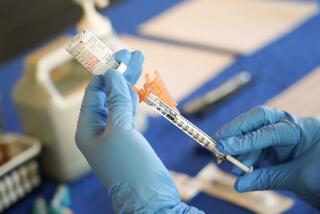You might need a COVID booster yearly. But this virus is still nothing like the flu

- Share via
Should everyone eligible get the new Omicron-specific COVID booster? Yes, absolutely. But we should not get lulled into the illusion that the fight against COVID is over and now comparable to preventing the flu.
The deaths from COVID-19 in the U.S. this year make the case for boosters: Although unvaccinated people remain the majority of deaths, the proportion of vaccinated individuals dying in America has increased (42% of deaths last January and February, compared with 23% in September 2021).
Vaccinated patients who die have disproportionately been those 75 and older who have not received a booster; 75% of vaccinated seniors in California who died in January and February this year weren’t boosted. In San Francisco, when talking to families of vaccinated individuals who died, I’ve often learned that the patient rushed to get their first two shots after the vaccine was authorized in December 2020 but had not received a booster despite third shots being greenlit last fall.
Whenever you opt to roll up your sleeve, it’s important to note that it takes two weeks for the full effect of the booster to hit.
Thus the FDA’s recent authorization of new boosters is good news. These shots contain half the original vaccine formulation and half instructions to target the BA.4 and BA.5 Omicron strains — which currently account for almost all COVID-19 infections and serious disease. This is a chance to make a real dent in the legions of vaccinated folks, particularly older people, experiencing breakthrough infection.
The use of the new booster is supported by the logic behind flu vaccines. Seasonal influenza vaccines are updated annually from a tried-and-true formulation to match the viral strains circulating elsewhere in the world. Because we have had enough experience with prior versions of the flu vaccine, there is less need to mandate clinical trials in humans before approval. The goal is to have the shots ready before the virus surges. In applying this strategy to COVID, officials approved the new booster in time for a possible fall surge without waiting for robust clinical data on its efficacy.
This approach is reasonable and has led to White House officials announcing that the U.S. may make its COVID vaccination strategy annual, in line with flu shots. But we have to be cautious about raising unrealistic expectations of what this means for the pandemic’s future.
First, a vaccination campaign that matches our approach to the flu does not make COVID itself comparable to the flu. Even with increased population immunity, COVID is settling into an annual death toll that scientists believe could exceed 100,000 — several-fold higher than a typical flu season and potentially exceeding annual diabetes deaths. COVID continues to mutate much faster than flu typically does. And even with decades of experience predicting and vaccinating against influenza, the flu vaccine has sometimes missed the mark.
Additionally, we don’t yet know if the new booster will be more effective than the original vaccine at preventing breakthrough infection. Research indicates that getting prior versions of the booster reduced risk of infection and hospitalization in adults compared with just getting the two-dose vaccine, and unpublished studies from Pfizer and Moderna found that earlier booster formulations targeting the original Omicron variant (BA.1) produced high levels of neutralizing antibodies against that strain, with similar adverse effects as the original vaccine.
But antibody levels don’t always correlate with infection prevention. So although we can be confident the new booster is safe, we’re not sure if we have a successful template to protect against whatever new strains emerge and dominate infection year to year.
To deploy the Omicron-specific shots and the money to pay for them wisely, we need less hype and more information.
We also don’t know how long protection will last. If BA.5 remains dominant through the winter, the BA.5 booster will likely prevent breakthrough infection for several months. In the same vein, individuals who were recently infected with COVID will probably retain protection against infection for at least three months. But all bets are off if we see a brand new variant that has undergone an evolutionary leap from Omicron (the Pis, Rhos or Sigmas).
Finally, we need to understand how much effect the new vaccines will have on the development of long COVID, the disabling host of physical and mental symptoms that can afflict people for months and even years. Some evidence suggests that vaccination reduces the risk of long COVID and even lessens the chronic symptoms. However, we need more information about the magnitude of the protective effect, particularly for the new booster formulation.
There are still tens of millions of Americans who still haven’t received a single booster — or any vaccine at all. A lack of vaccination will continue to drive deaths. But whether a routine annual booster shot will make us nimble against future variants depends on what happens as the virus evolves. If we have learned anything from this pandemic, it should be to treat this shape-shifting threat with humility.
Federal vaccine initiatives alone won’t keep COVID in check. Since federal COVID dollars are drying up and the Centers for Disease Control and Prevention relaxed behavioral guidelines, it is incumbent upon states and local governments to have a Plan B so that they can respond in the event of local surges. This includes having reserve funds to provide free, equitable and convenient testing to supplement early therapy. Masks continue to be a cheap, effective and easy tool that still needs to be part of public health messages put out by community leaders. Now is not the time to throw out any tried-and-true strategies, beyond the vaccine, that we may well need again.
Peter Chin-Hong is a professor of medicine and an infectious disease specialist at UC San Francisco. @PCH_SF
More to Read
A cure for the common opinion
Get thought-provoking perspectives with our weekly newsletter.
You may occasionally receive promotional content from the Los Angeles Times.










